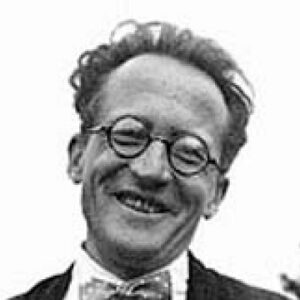Erwin Schrodinger was an Austrian theoretical physicist who shared the Nobel Prize in physics with P.A.M. Dirac for his contributions to the theory of matter and quantum mechanics. Erwin demonstrated a wide range of interests throughout his time at the ‘Akademisches Gymnasium,’ including scientific fields, ancient grammar, and German poetry. Fritz Hasenohrl educated him at the University of Vienna, and he learned a lot about eigenvalue problems. Later, he continued his experimental physics studies under K.W.F Kohlrausch and as Franz Exner’s assistant. He served as an artillery officer during World War I and then went on to pursue a career in academia after the war. Schrodinger’s time at the ‘University of Zurich’ was his most productive in theoretical physics, culminating in his most famous discovery, Schrodinger’s wave equation. His appointment as Planck’s successor in Berlin was strategic, but it was short-lived when Hitler came to power. Erwin continued to change universities, and when his birthplace Austria was invaded after WWII, he found himself in a tough situation and had to flee to Italy. Erwin finally settled in ‘Advanced Studies of Dublin’ after years of relocation, where he taught until his retirement. After his retirement, Erwin accepted an honorary appointment in Vienna.
Childhood and Adolescence
Erwin Schrodinger was born in Vienna on August 12, 1887, to Rudolf and Emily Bauer. His father was Austrian, and his mother was half-British and half-Austrian, therefore he had mixed ancestry.
His father owned a small linoleum factory and was a well-educated guy who studied chemistry, Italian painting, and botany, as well as published various studies in plant phylogeny.
Schrodinger was home-schooled until he was eleven years old and spoke German and English fluently.
He was accepted into the ‘University of Vienna’ in 1906 after graduating from the ‘Akademisches Gymnasium,’ and was highly affected by Fritz Hasenohrl’s theoretical physics lectures.
Schrodinger was awarded a doctorate for his dissertation, ‘On the conduction of electricity on the surface of insulators in wet air,’ on May 20, 1910.
In 1911, Erwin was offered a position as an experimental physics assistant to Franz Exner, an experience he subsequently regarded as crucial for his theoretical work because the experiments gave a realistic basis for his theoretical concepts.
During World War I, he served in fortress artillery as a volunteer.
Erwin was awarded the ‘Habilitation,’ the highest academic degree recognizing independent scholarship, on September 1st, 1914.
The Career of Erwin
He continued his study work while serving in the military from 1915 to 1920, and he published several research publications. He also taught a meteorology course in Hungary.
He began working as an assistant to Max Wein in 1920 and then attended the ‘University of Stuttgart’ and ‘The University of Zurich.’
He had the company of some of his famous colleagues including Peter Debye and Hermann Weyl throughout his six-year stay at the ‘University of Zurich.’ His research focused on thermodynamics, atomic spectra, the nature of specific temperatures in materials, and color theory.
He published his results on quantum wave mechanics in six publications over the period of six months in 1926, when he was 39 years old, and they became known as Schrodinger’s wave equation.
Erwin accepted an invitation in 1927 to succeed Max Planck, the founder of the quantum theory, at the ‘University of Berlin,’ where he met Albert Einstein, the famed theoretical physicist.
He was a member of the prestigious faculty until 1933, when he refused to comply with Hitler’s anti-Semitic measures, leading to a seven-year relocation to Austria, the United Kingdom, Belgium, Rome, and eventually Berlin.
Erwin moved to Dublin and became the Director of the School for Theoretical Physics at the Institute of Advanced Studies, where he stayed until his retirement in 1955.
In 1961, he released his final work, ‘Meine Weltansicht,’ in Vienna, which revealed his metaphysical viewpoint.
Erwin’s Major Projects
Schrodinger established wave mechanics as a foundation for understanding the behavior of light and subatomic particles.
He explained that the distinct stages of an atom’s electrons can be defined and their state of energy may be anticipated using the wave equation in his theory known as the ‘Schrodinger Equation.’ Quantisierungals Eigenwert Problem’ or ‘Quantization as an Eigenvalue Problem’ was the title of his paper.
Achievements & Awards
Erwin received the highest academic degree in Germany, the Habilitation, at the age of 27 in 1914. This prize is given to students who excel in independent scholarship.
Erwin Schrodinger was given the Nobel Prize in Physics in 1933, which he shared with Paul A.M. Dirac, a British physicist. His ‘discovery of new productive types of atomic theory’ earned him the prize.
Personal History and Legacy
He married Annemarie Bertel in 1920 after they had been engaged the year before when Anny came to Vienna to work as a secretary.
Schrodinger had a soft spot for a number of ladies in his life, including Hilde March’s wife. Ruth Georgia Erica, his daughter, was born out of wedlock with Hilde in Oxford in 1934. He had two more daughters from two separate Irish ladies during his time in Dublin.
After a protracted battle with TB, the distinguished scientist passed away on January 4, 1961. He was laid to rest in a Catholic cemetery in the Austrian town of Alpbach.
Schrödinger began an intriguing mind experiment known as Schrödinger’s Cat, in which he explained the strange behavior of electrons.
A deadly gas source was placed inside a box containing a cat. At one point, the erratic behavior of electrons perplexed the onlooker, making it difficult to determine whether the cat was alive or dead.
Estimated Net worth
Erwin is one of the wealthiest physicists and one of the most well-known physicists. Erwin Schrodinger’s net worth is estimated to be $85 million.


